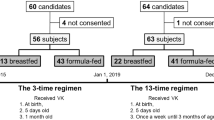Abstract
The influence of breast or formula feeding together with that of a single supplementation of vitamin K1 at birth, on the vitamin K1 level and vitamin K-dependent clotting factors were studied in 65 breast and 15 formula fed infants. All breast fed newborns without supplementation (n=25) had very low serum vitamin K1 at weeks 1 and 6. Oral vitamin K supplementation (n=22) or i.m. (n=18) at birth resulted in high serum levels at week 1, while at week 6 the effect had disappeared. Formula fed infants had vitamin K1 values within the normal adult range at all study points. The low serum levels of vitamin K1 were not associated with haemorrhagic disorders or coagulation abnormalities. The mean values of vitamin K1 in maternal sera at weeks 1 and 6 were 2.3 nmol/l and 1.8 nmol/l and in breast milk 2.7 nmol/l and 2.0 nmol/l respectively. No correlation existed between the values in breast milk and maternal serum. To maintain serum levels of vitamin K1 within the adult physiological range, repeated administration of low doses is needed in breast fed newborns beyond 1 week of age.
Similar content being viewed by others
References
Andrew M, Paes B, Milner R, Johnston M, Mitchell L, Tollefsen DM, Powers P (1987) Development of the human coagulation system in the full-term infant. Blood 70:165–172
Bertina RM, Van der Marel-van Nieuwkoop W, Dubbeldam J, Boekhout-Mussert RJ, Veltkamp JJ (1980) New method for the rapid detection of vitamin K1 deficiency. Clin Chim Acta 105:93–98
Büller H, Peters M, Burger B, Nagelkerke N, Ten Cate JW, Breederveld C, Heymans H, (1986) Vitamin K status beyond the neonatal period: a prospective study in normal breast-fed and formula-fed infants. Eur J Pediatr 145:496–499
Canfield LM, Hopkinson JM, Lima AF, Silva B, Garza C (1991) Vitamin K in colostrum and mature milk over the lactation period; a cross-sectional study. Am J Clin Nutr 53:730–735
Greer FR, Mummah-Schendel LL, Marshall S, Suttie JW (1988) Vitamin K1 (Phylloquinone) and vitamin K2 (Menaquinone) status in newborns during the first week of life. Pediatrics 81:137–140
Haard PMM van, Engel R, Pietersma-de Bruyn ALJM (1986) Quantitation of trans-vitamin K1 in small serum samples by off-line multidimensional liquid chromatography. Clin Chim Acta 157:221–230
Haard PMM van, Engel R, Postma T (1987) Routine clinical determination of carotene, vitamin E, vitamin A, 25-hydroxy vitamin D3 and trans-vitamin K1 in human serum by straight phase HPLC. Biomed Chromatogr 2:79–88
Haroon Y, Shearer MJ, Rahim S, Gunn WG, McEnery G, Barkhan P (1982) The content of Phylloquinone (vitamin K1) in human milk, cows milk and infant formula foods determined by high-performance liquid chromatography. J Nutr 112:1105–1117
Kries R von, Shearer MJ, McCarthy PT, Haug M, Harzer G, Göbel U (1987) Vitamin K1 content of maternal milk: influence of the stage of lactation, lipid composition, and vitamin K1 supplements given to the mother. Pediatr Res 22:513–517
Olson JA (1987) Recommended dietary intakes (RDI) of vitamin K in humans. Am J Clin Nutr 45:687–692
Pietersma-de Bruyn ALJM, Haard PMM van, Beunis MH, Hamulyak K, Kuijpers JC (1990) Vitamin K1 levels and coagulation factors in healthy term newborns till 4 weeks after birth. Haemostasis 20:8–14
Quick AJ (1935) The prothrombin in haemophilia and obstructive jaundice. J Biol Chem 109:73
Shearer MJ, Rahim S, Barkhan P, Stimmler L (1982) Plasma vitamin K1 in mothers and their newborn babies. Lancet 2: 460–463
Sturk A, Morriën-Salomons WM, Huisman MV, Borm JJJ, Büller HR, Cate JW ten (1987) Analytical and clinical evaluation of commerical protein C assays. Clin Chim Acta 165:263–270
Uitentuis J (1990) Vitamin K administration to newborns and infants (in Dutch). Ned Tijdschr Geneeskd 134:1642–1646
Author information
Authors and Affiliations
Rights and permissions
About this article
Cite this article
Hogenbirk, K., Peters, M., Bouman, P. et al. The effect of formula versus breast feeding and exogenous vitamin K1 supplementation on circulating levels of vitamin K1 and vitamin K-dependent clotting factors in newborns. Eur J Pediatr 152, 72–74 (1993). https://doi.org/10.1007/BF02072521
Received:
Accepted:
Issue Date:
DOI: https://doi.org/10.1007/BF02072521




